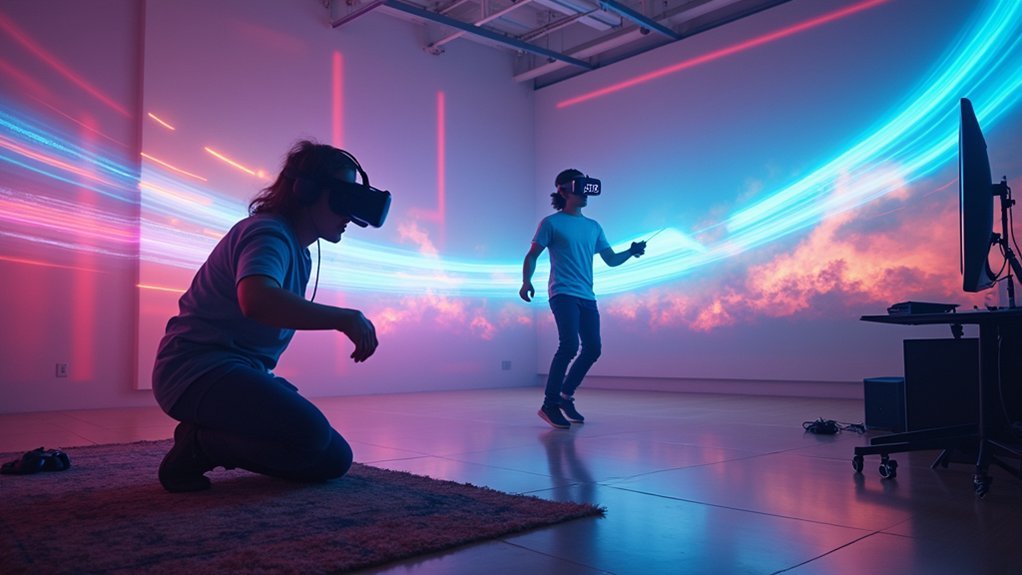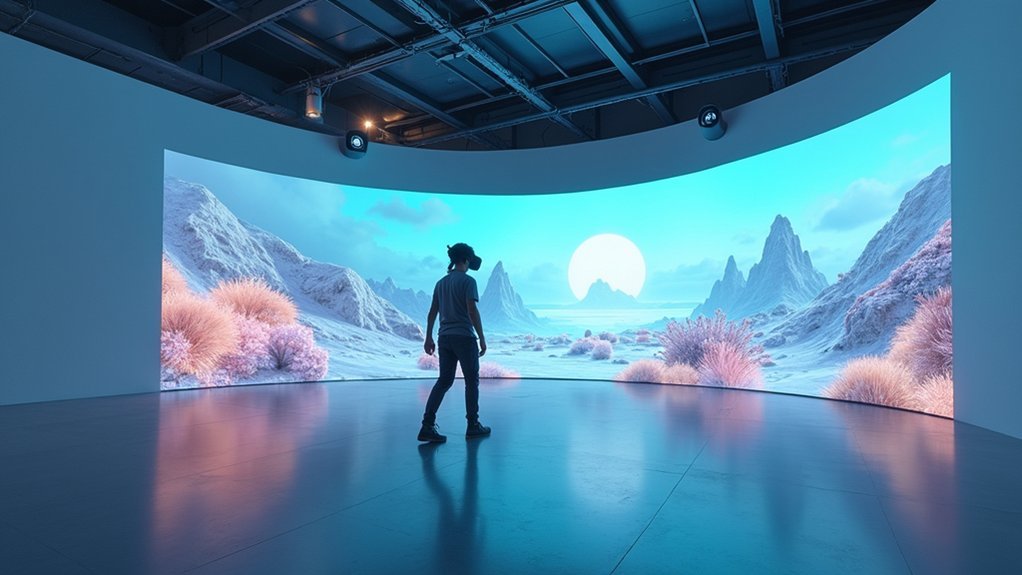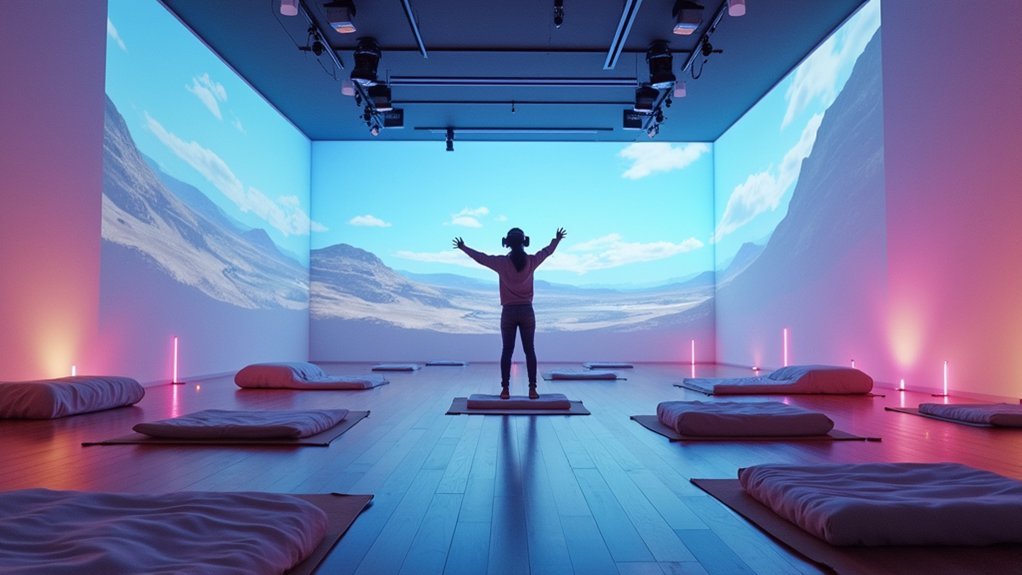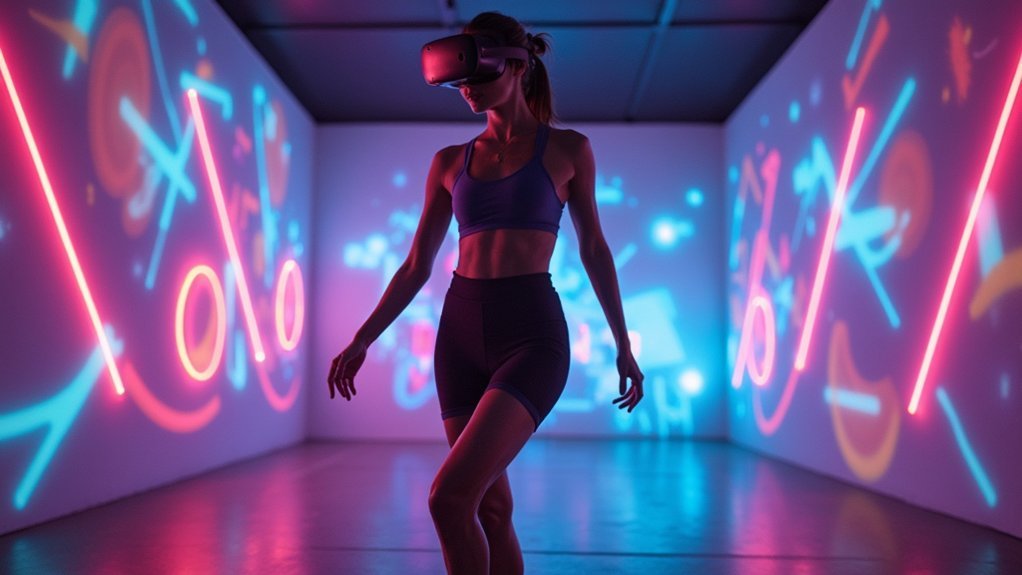You’ll experience 40% longer engagement with room-scale VR because it transforms you from a passive observer into an active participant within a 5-meter play area. Unlike standing VR, you can naturally walk, duck, and reach while building genuine spatial memories and authentic interactions. Your brain processes virtual environments more effectively through physical movement, creating deeper emotional connections and enhanced memory retention. The technical requirements and setup costs reveal important considerations for your decision.
Enhanced Physical Freedom and Natural Movement

When you choose room-scale VR over standing movement, you’re unblocking a transformative level of physical freedom that fundamentally changes how you interact with virtual environments.
You’ll gain access to a 5-meter diagonal play area where you can walk freely, creating an immersive experience that standing VR simply can’t match with its limited, stationary footprint.
This expanded space enables natural physical movement that mirrors real-life actions. You can duck under obstacles, dodge incoming threats, and reach out to interact with objects using your entire body.
Room-scale VR transforms you from a passive observer into an active participant who moves intuitively through virtual worlds. This natural movement pattern feels authentic because it aligns with how you’d naturally respond in real situations, making every interaction more engaging and believable.
Superior Immersion Through Spatial Awareness
When you move naturally through room-scale VR, your brain processes spatial relationships just as it would in the real world, creating an unmatched sense of presence that standing VR can’t replicate.
You’ll develop an intuitive understanding of your virtual surroundings as you physically navigate the space, building genuine spatial memories that enhance your connection to the digital environment.
This heightened spatial awareness comes from your body’s ability to recognize physical boundaries and distances, making every virtual interaction feel authentic and grounded in reality.
Natural Walking Mechanics
Although standing VR offers basic head and arm tracking, room-scale VR transforms your virtual experience by letting you walk naturally through digital environments. This freedom creates unprecedented immersion that standing setups simply can’t match.
Your natural walking mechanics become the foundation for exploration, allowing you to:
- Navigate intuitively – Walk, duck, and lean as you’d in real life
- Build spatial awareness – Develop genuine understanding of virtual distances and layouts
- Engage your whole body – Use natural movements instead of artificial locomotion
- Retain experiences better – Physical engagement enhances memory formation
Room-scale setups require minimum 2m x 2m space but deliver authentic movement that mirrors real-world navigation.
You’ll find yourself genuinely exploring rather than artificially teleporting, creating deeper connections with virtual environments through natural, unrestricted movement patterns.
Enhanced Spatial Presence
Room-scale VR creates a profound sense of spatial presence that fundamentally changes how you perceive and interact with virtual worlds.
When you’re free to physically move through designated areas, your brain naturally maps the virtual environment to real space, creating enhanced spatial awareness that standing VR simply can’t match. This freedom to walk, duck, and lean mirrors real-world movement patterns, making interactions feel authentic and intuitive.
Your ability to explore 360° without positional constraints deepens emotional engagement with virtual content.
Research shows that room scale environments generate stronger feelings of realism and immersion compared to confined standing experiences. The accurate tracking technology provides seamless navigation feedback, allowing you to move confidently within virtual spaces while maintaining that vital sense of presence.
Physical Boundary Recognition
While standing VR confines you to a fixed position, room-scale technology transforms your relationship with virtual boundaries through sophisticated spatial recognition systems.
Room-scale VR empowers you to confidently navigate virtual worlds while maintaining awareness of your physical environment.
The chaperone system creates intelligent physical boundaries that enhance your experience:
- Real-time alerts appear when you approach play area edges, preventing collisions with walls or furniture.
- Visual grid overlays seamlessly integrate into your virtual environment without breaking immersion.
- Customizable boundary settings let you adjust sensitivity levels based on your specific room layout.
- Dynamic tracking continuously monitors your position, ensuring consistent safety throughout extended sessions.
This sophisticated boundary recognition eliminates the anxiety of bumping into objects, allowing you to focus entirely on exploration and interaction within your virtual space.
Technical Requirements and Space Considerations
You’ll need to evaluate your available space before committing to room-scale VR, as it requires a minimum 2m x 2m area compared to standing VR’s compact 1m x 1m footprint.
Your hardware setup becomes more complex with room-scale systems, demanding additional base stations or sensors to track your full-body movement throughout the play area.
The technical investment includes not just extra equipment costs but also the time you’ll spend configuring tracking systems like Valve’s Lighthouse technology for peak performance.
Minimum Space Requirements
Before diving into room-scale VR, understanding the physical space requirements becomes essential for making an informed decision.
You’ll need considerably more area compared to standing experiences, but the enhanced immersion makes it worthwhile.
Here are the key space requirements you should consider:
- Minimum viable space: 2m x 2m allows basic room-scale VR with full arm movement and safe navigation.
- Optimal experience: 4m x 4m provides comfortable walking and exploring capabilities within virtual environments.
- Standing alternative: 1m x 1m works for standing experiences but severely limits 360° movement potential.
- Maximum capability: HTC Vive supports up to 5 meters diagonally using advanced positional tracking technology.
Most users find clearing at least 3m x 3m necessary for truly satisfying room-scale VR experiences.
Hardware Setup Differences
Beyond space considerations, the technical hardware and software requirements between room-scale and standing VR systems differ markedly in complexity and cost.
When you’re setting up room-scale VR, you’ll need more sophisticated tracking technology. The HTC Vive exemplifies this with its Lighthouse system, utilizing two base stations that emit laser patterns for precise positional tracking throughout your play area. You’ll also need to carefully position these sensors for maximum coverage.
If you’re using an Oculus Rift for full room-scale experiences, you’ll require a third sensor beyond the standard two-sensor configuration, adding extra expense.
Standing VR setups are considerably simpler, requiring fewer sensors and less calibration. Additionally, room-scale environments demand proper lighting and appropriate flooring to guarantee safe navigation, while standing setups have minimal environmental requirements.
Gaming Performance and User Engagement Benefits

When you choose room-scale VR over standing movement, you’ll experience greatly enhanced gaming performance through precise positional tracking that captures every duck, lean, and step with remarkable accuracy.
This technology transforms how you interact with virtual worlds, creating dynamic gameplay that keeps you engaged longer than traditional VR setups.
Room-scale VR delivers superior user engagement through:
Room-scale VR transforms virtual experiences by delivering unmatched user engagement through natural movement and immersive interaction capabilities.
- Physical Movement Freedom – You can walk, crouch, and reach naturally within your play space.
- Enhanced Immersion – Your body becomes the controller, creating deeper presence in virtual worlds.
- Improved Retention – Studies show room-scale VR users stay engaged 40% longer than standing-only experiences.
- Better Learning Outcomes – Physical movement enhances cognitive retention, making educational games more effective.
You’ll find room-scale VR accommodates various play styles while boosting physical activity during gameplay.
Practical Limitations and Accessibility Challenges
While room-scale VR offers compelling gaming advantages, you’ll face significant spatial requirements that make this technology inaccessible for many home setups.
You need a minimum 2m x 2m area for basic room-scale VR functionality, though ideal experiences demand around 4m x 4m spaces. Most users struggle to clear even the minimum area required for safe navigation.
Standing VR eliminates these constraints, allowing you to enjoy immersive experiences in rug-sized spaces.
You’ll also avoid additional costs like Oculus Rift’s third sensor requirement for full 360° tracking.
These space limitations have narrowed room-scale VR’s market appeal, pushing developers toward standing or seated experiences that reach broader audiences.
If you’re working with limited space, standing VR provides a more practical and accessible entry point into virtual reality.
Future Market Trends and Development Focus

Despite current spatial limitations, market forces are rapidly shifting toward room-scale VR as the industry’s preferred development target.
Market dynamics are accelerating the VR industry’s pivot toward room-scale experiences despite existing space constraints.
You’ll find developers increasingly prioritizing room-scale experiences over stationary gameplay, recognizing that physical movement creates deeper engagement. This trend reflects consumer demand for more immersive content that gets you fully immersed in virtual worlds.
The market’s evolution toward room-scale VR shows several key indicators:
- Platform Competition – Oculus and HTC Vive’s rivalry drives continuous room-scale technology improvements
- Content Migration – Significant portions of VR libraries now emphasize standing and room-scale gameplay
- Space Innovation – Developers create engaging experiences for smaller areas while preserving room-scale interactivity
- Technology Advancement – Enhanced tracking systems expand room-scale possibilities, attracting specialized content creation
This momentum suggests room-scale VR will become the standard for future gaming experiences.
Frequently Asked Questions
What Is the Difference Between Stationary and Roomscale?
Stationary VR confines you to a 1m x 1m area with limited movement, while room-scale VR lets you walk freely within a larger 5-meter space, enabling natural walking and enhanced immersion.
What Is the Difference Between Roomscale and Standing Psvr2?
You’ll move freely across 5 meters with roomscale VR, while PSVR2’s standing experience keeps you stationary. Roomscale lets you duck, lean, and walk around objects, but PSVR2 only tracks 360° rotation.
What Does Room Scale VR Allow?
Room scale VR allows you to move freely within a tracked physical space, letting you walk, duck, and lean naturally. You’ll experience enhanced immersion while safety systems prevent you from hitting walls or obstacles.
What Is Room Scale in Meta Quest 3?
Room scale in Meta Quest 3 lets you move freely within a designated play area that’s at least 6.5 by 6.5 feet, using advanced tracking to monitor your natural walking movements.





Leave a Reply